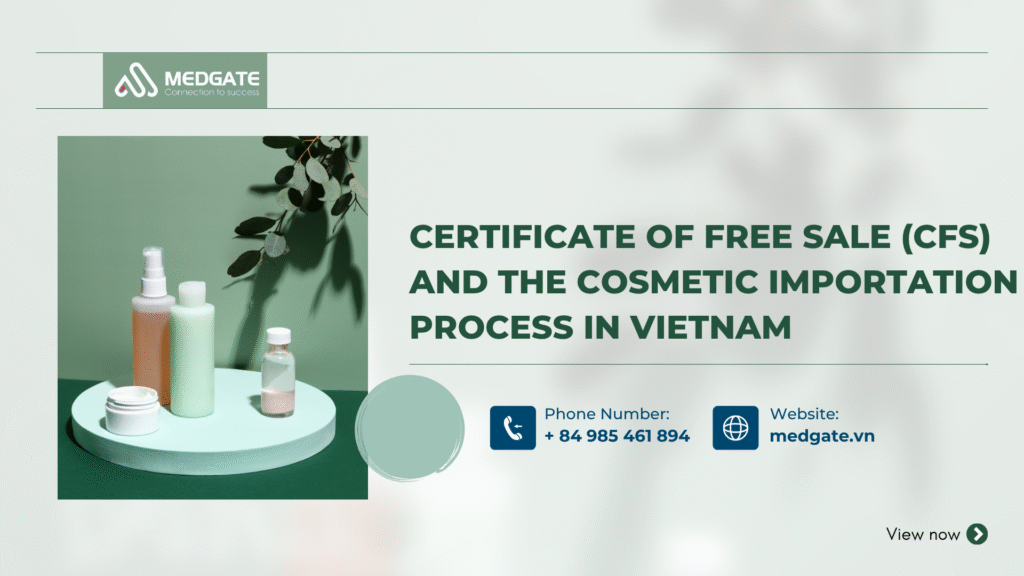When a company imports cosmetics into the Vietnamese market, understanding the legal procedures is essential to avoid shipment delays and administrative risks. One of the key documents required for product registration and importation is the Certificate of Free Sale (CFS). This article explains what a CFS is, its importance, and the main steps in importing cosmetics into Vietnam legally and efficiently.
What is a CFS and Why It Matters
A Certificate of Free Sale (CFS) is an official document issued by a competent authority in the exporting or manufacturing country, confirming that the product is legally marketed and freely sold there. For imported cosmetics, the CFS serves as proof of product legitimacy and safety, required as part of the product registration dossier. The CFS must be an original copy or a legalized authenticated duplicate as stipulated by the Vietnamese authorities.
Preparation Before Importation
Before the goods are shipped, the importer must complete the product notification procedure with the relevant health authority. This notification serves as a declaration of product safety and compliance. Any cosmetic that has not been duly notified cannot be cleared through customs.
Key Steps in the Cosmetic Importation Process
1. Prepare the Product Notification Dossier
- Cosmetic Product Notification Form
- Business registration certificate of the responsible company in Vietnam
- Power of Attorney from the manufacturer or product owner (if the importer is not the owner)
- Certificate of Free Sale (CFS) or equivalent document issued by the exporting country
- Product composition list and detailed product information
2. Submit and Obtain the Notification Number
Once the dossier is complete and valid, the competent authority will issue a Product Notification Number, which must be referenced in the customs declaration. If the dossier is incomplete, the authority will request additional information or corrections.
3. Prepare the Customs Documentation
- Sales contract, commercial invoice, packing list, bill of lading or airway bill
- Certificate of Origin (C/O) to claim preferential tariffs (if applicable)
- Product Notification Number issued by the Ministry of Health
Importers must also determine the correct Code Dossier to declare the applicable import duty and VAT. Any misclassification may lead to fines or confiscation.
4. Customs Declaration and Clearance
Importers must file an electronic customs declaration, pay import duties and taxes, and cooperate with customs officers during document or physical inspections. Once cleared, goods may be released from the port to the importer’s warehouse.
5. Labeling and Market Distribution
Before distribution, all products must bear a Vietnamese label (or a supplementary label) including:
- Product name and intended use
- Ingredient list
- Usage instructions and safety warnings (if any)
- Country of origin, name and address of the responsible entity in Vietnam
- Batch number, manufacturing and expiry dates. All information must be consistent with the approved product notification dossier.
Common Risks and How to Avoid Them
- Expired or invalid CFS – may result in rejection or clearance delays. Always verify the validity and legalization status of your CFS.
- Incorrect HS Code or missing C/O – can increase import costs or disqualify tariff preferences. Consult experienced customs brokers or logistics specialists.
- Labeling inconsistencies – may lead to administrative penalties or product recalls. Ensure all labeling matches the notified information.
Importing cosmetics into Vietnam requires careful preparation — from product notification and CFS submission to customs clearance and labeling compliance. Understanding each step and maintaining accurate documentation minimizes risks, saves time and costs, and ensures consumer safety. For companies seeking assistance with dossier preparation, CFS verification, or customs procedures, partnering with a professional legal or logistics service provider is a smart and efficient solution.


 Tiếng Việt
Tiếng Việt
